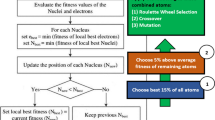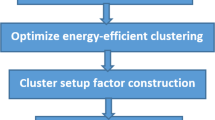Abstract
The edge/fog computing has the potential to gear up the healthcare industry by providing better and faster health services to the patients. In healthcare systems where every second is crucial, the edge computing can be helpful to reduce the time between data capture and analytics in a powerful manner. In edge computing, the network edge devices are configured in such a manner that they can handle critical analysis and make necessary decisions instead of sending the captured health data directly to the cloud. However, lifetime of the edge network is a critical factor and thus an energy efficient network architecture has to be designed to achieve the above mentioned goal. In this regard, this research presents a new extremal optimization tuned micro genetic algorithm (EO-μGA) based clustering technique for the sake of efficient routing and prolonging network lifetime by saving the battery power of network edge devices. Moreover, a novel fitness function with a set of relevant criteria of edge devices such as energy factor, average intra-cluster distance, average distance to cluster leader over data analytics center, average sleeping time, and computational load has been considered for the selection of the cluster leader which will be responsible for managing intra-cluster and inter-cluster data communication. The simulation results show that the proposed EO-μGA based clustering model offers a higher network lifetime and a least amount of transmission energy consumption per node as compared to various state of the art optimization algorithms.









Similar content being viewed by others
References
Aazam, M., Khan, I., Alsaffar, A. A., & Huh, E. N. (2014). Cloud of Things: Integrating Internet of Things and Cloud Computing and the Issues Involved. In Proc. of 11th international Bhurban conference on applied sciences and technology (Vol. 414–19, p. 2014). IBCAST.
Aazam, M., Huh, E. N., St-Hilaire, M., Lung, C. H., & Lambadaris, I. (2015). Cloud of things: Integration of IoT with cloud computing. Robots and Sensor Clouds., 36, 77–94.
Abidoye, A. P., & Obagbuwa, I. C. (2017). Models for integrating wireless sensor networks into the internet of things. IET Wireless Sensor Systems., 7(3), 65–72.
Akgül, Ö. U., & Canberk, B. (2016). Self-organized things (SoT): An energy efficient next generation network management. Computer Communications, 74, 52–62.
Bagula, A., Abidoye, A. P., & Zodi, G. A. L. (2015). Service-aware clustering: An energy-efficient model for the internet-of-things. Sensors., 16(1), 9.
Barger, M., Brown, T., & Alwan, D. (2005). Health status monitoring through analysis of behavioral patterns. IEEE Transactions on Systems, Man, and Cybernetics - Part A: Systems and Humans, 35(1), 22–27.
Bhatia, M., & Sood, S. K. (2017). A comprehensive health assessment framework to facilitate IoT-assisted smart workouts: A predictive healthcare perspective. Computers in Industry., 92, 50–66.
Boettcher, S., & Percus, A. G. (2003). Extremal optimization: An evolutionary local-search algorithm. Operations Research/ Computer Science Interfaces Series., 21, 61–77.
Botta, A., De Donato, W., Persico, V., & Pescapé, A. (2016). Integration of cloud computing and internet of things: A survey. Future Generation Computer Systems., 56, 684–700.
Catarinucci, L., De Danilo, D., Luca, M., Luca, P., Luigi, P., Maria, S. L., & Luciano, T. (2015). An IoT-aware architecture for smart healthcare systems. IEEE Internet of Things Journal., 2(6), 515–526.
Chakravarty, S., Mittra, R., & Williams, N. R. (2002). Application of a microgenetic algorithm (MGA) to the design of broadband microwave absorbers using multiple frequency selective surface screens buried in dielectrics. IEEE Transactions on Antennas and Propagation, 50(3), 284–296.
Chang, J. Y. (2015). A Distributed Cluster Computing Energy-Efficient Routing Scheme for Internet of Things Systems. Wireless Personal Communications, 82(2), 757–776.
Chen, X., Ma, M., & Liu, A. (2017). Dynamic power management and adaptive packet size selection for IoT in e-healthcare. Computers and Electrical Engineering, 65, 1–19.
Díaz, M., Martín, C., & Rubio, B. (2016). State-of-the-art, challenges, and open issues in the integration of internet of things and cloud computing. Journal of Network and Computer Applications., 67, 99–117.
Gelogo, Y. E., Hwang, H. J., & Kim, H. (2015). Internet of things ( IoT ) framework for u-healthcare system. International Journal of Smart Home., 9(11), 323–330.
Hao, L., Gang, X., Gui, Y. D., & Yu, B. S. (2014). Human behavior based particle swarm optimization, The Scientific World Journal. Hindawi Publishing Corporation, 2014, 1–10.
Holland, J. H. (1992). Genetic algorithms. Scientific American, 267(1), 66–73.
Hossain, M. S. (2017). Cloud-supported cyber-physical localization framework for patients monitoring. IEEE Systems Journal., 11(1), 118–127.
Hossain, M. S., & Muhammad, G. (2016). Cloud-assisted industrial internet of things (IIoT) - enabled framework for health monitoring. Computer Networks, 101, 192–202.
Hussain, A., Wenbi, R., Lopes, A., Nadher, M., & Mudhish, M. (2015). The journal of systems and software health and emergency-care platform for the elderly and disabled people in the Smart City. The Journal of Systems & Software, 110, 253–263.
Jin, J., Gubbi, J., Marusic, S., & Palaniswami, M. (2014). An information framework for creating a smart city through internet of things. IEEE Internet of Things Journal, 1(2), 112–121.
Kaur, N., & Sood, S. K. (2017). An energy-efficient architecture for the internet of things (IoT). IEEE Systems Journal, 11(2), 796–805.
Kennedy, J. and Eberhart, R. C., Particle Swarm Optimization. Proceedings of the 1995 IEEE International Conference on Neural Networks, IEEE Service Center, Piscataway, NJ, 1995.
Krishnakumar, K. (1990). Micro-genetic algorithms for stationary and non-stationary function optimization. Intelligent control and adaptive systems, International Society for Optics and Photonics, 1196, 289–297.
Laskar, N. M., Guha, K., Chatterjee, I., Chanda, S., Baishnab, K. L., & Paul, P. K. (2019). HWPSO: A new hybrid whale-particle swarm optimization algorithm and its application in electronic design optimization problems. Applied Intelligence, 49(1), 265–291.
Liang, J. M., Chen, J. J., Cheng, H. H., & Tseng, Y. C. (2013). An energy-efficient sleep scheduling with QoS consideration in 3GPP LTE-advanced networks for internet of things. IEEE Journal on Emerging and Selected Topics in Circuits and Systems., 3(1), 13–22.
Majumdar, A., Debnath, T., Sood, S. K., & Baishnab, K. L. (2018). Kyasanur Forest disease classification framework using novel Extremal optimization tuned neural network in fog computing environment. Journal of Medical Systems, 42(10), 187.
Majumdar, A., Laskar, N. M., Biswas, A., Sood, S. K., & Baishnab, K. L. (2019). Energy efficient e-healthcare framework using HWPSO-based clustering approach. Journal of Intelligent & Fuzzy Systems, 36(5), 3957–3969.
Mirjalili, S. (2016). Dragonfly algorithm: A new meta-heuristic optimization technique for solving single-objective, discrete, and multi-objective problems. Neural Computing and Applications, 27(4), 1053–1073.
Mirjalili, S., & Lewis, A. (2016). The whale optimization algorithm, Advances in Engineering Software. Elsevier, 95, 51–67.
Orsino, A., Araniti, G., Militano, L., Alonso-Zarate, J., Molinaro, A., & Iera, A. (2016). Energy efficient IoT data collection in smart cities exploiting D2D communications. Sensors, 16(6), 836.
Praveen Kumar Reddy, M., & Rajasekhara Babu, M. (2017). Energy Efficient Cluster Head Selection for Internet of Things. New Review of Information Networking, 22(1), 54–70.
Rahmani, A. M., Nguyen, T., Negash, B., & Anzanpour, A. (2018). Exploiting smart e-health gateways at the edge of healthcare internet-of-things: A fog computing approach. Future Generation Computer Systems, 78, 641–658.
Rani, S., Talwar, R., Malhotra, J., Ahmed, S. H., Sarkar, M., & Song, H. (2015). A novel scheme for an energy efficient internet of things based on wireless sensor networks. Sensors., 15(11), 28603–28626.
Roy, R. K. (2001). Design of Experiments Using the Taguchi approach: 16 steps to product and process improvement. John Wiley and Sons, Inc.: Press.
Roy, R. K. Report# 1. Multiple Criteria of Evaluations for Designed Experiments. Available: http://nutek-us.com/wp-tec.html .
Saaty, T.L., The analytic hierarchy and analytic network processes for the measurement of intangible criteria and for decision-making. Multiple criteria decision analysis: state of the art surveys, Springer, New York, NY. 345–405, 2005.
Santos, D. F. S., Almeida, H. O., & Perkusich, A. (2015). A personal connected health system for the internet of things based on the constrained application protocol. Computers and Electrical Engineering., 44, 122–136.
Singh, A. K., Patowari, P. K., & Deshpande, N. V. (2016). Experimental analysis of reverse micro-EDM for machining microtool. Materials and Manufacturing Processes., 31(4), 530–540.
Song, L., Chai, K. K., Chen, Y., Schormans, J., Loo, J., & Vinel, A. (2017). QoS-aware energy-efficient cooperative scheme for cluster-based IoT systems. IEEE Systems Journal., 11(3), 1447–1455.
Tang, J., Zhou, Z., Niu, J., & Wang, Q. (2014). An energy efficient hierarchical clustering index tree for facilitating time-correlated region queries in the internet of things. Journal of Network and Computer Applications, 40, 1–11.
Verma, P., & Sood, S. K. (2018). Cloud-centric IoT based disease diagnosis healthcare framework. Journal of Parallel and Distributed Computing., 116, 27–38.
Wangikar, S. S., Patowari, P. K., & Misra, R. D. (2017). Effect of process parameters and optimization for photochemical machining of brass and german silver. Materials and Manufacturing Processes., 32(15), 1747–1755.
Whitmore, A., Agarwal, A., & Da Xu, L. (2015). The internet of things—A survey of topics and trends. Information Systems Frontiers, 17(2), 261–274.
Zhou, Z., Tang, J., Zhang, L. J., Ning, K., & Wang, Q. (2014). EGF-tree: An energy-efficient index tree for facilitating multi-region query aggregation in the internet of things. Personal and ubiquitous computing, 18(4), 951–966.
Acknowledgments
This publication is an outcome of the R&D work undertaken project under the Visvesvaraya PhD Scheme of Ministry of Electronics & Information Technology, Government of India, being implemented by Digital India Corporation.
Author information
Authors and Affiliations
Corresponding author
Additional information
Publisher’s Note
Springer Nature remains neutral with regard to jurisdictional claims in published maps and institutional affiliations.
Rights and permissions
About this article
Cite this article
Majumdar, A., Debnath, T., Biswas, A. et al. An Energy Efficient e-Healthcare Framework Supported by Novel EO-μGA (Extremal Optimization Tuned Micro-Genetic Algorithm). Inf Syst Front 23, 1039–1056 (2021). https://doi.org/10.1007/s10796-020-10016-5
Published:
Issue Date:
DOI: https://doi.org/10.1007/s10796-020-10016-5




